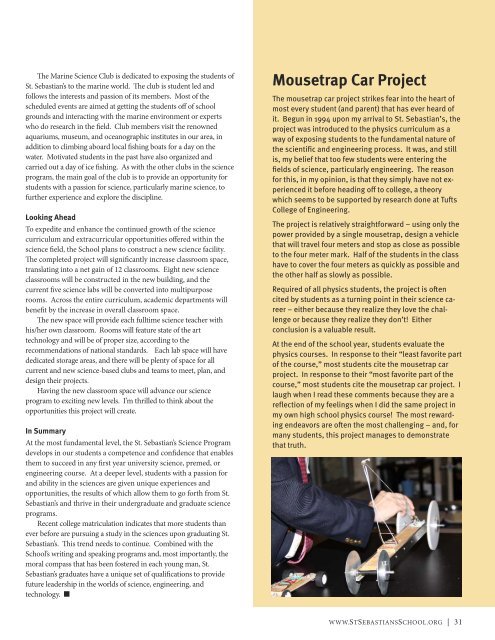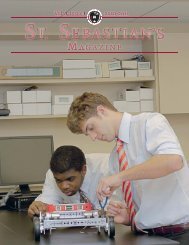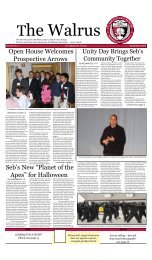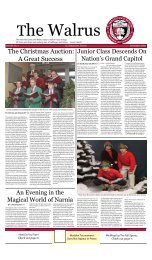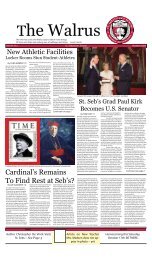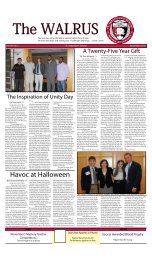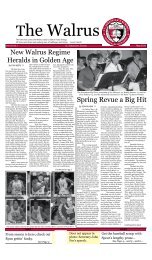ST SEBASTIAN’S
Issue I - St. Sebastian's School
Issue I - St. Sebastian's School
- No tags were found...
You also want an ePaper? Increase the reach of your titles
YUMPU automatically turns print PDFs into web optimized ePapers that Google loves.
The Marine Science Club is dedicated to exposing the students of<br />
St. Sebastian’s to the marine world. The club is student led and<br />
follows the interests and passion of its members. Most of the<br />
scheduled events are aimed at getting the students off of school<br />
grounds and interacting with the marine environment or experts<br />
who do research in the field. Club members visit the renowned<br />
aquariums, museum, and oceanographic institutes in our area, in<br />
addition to climbing aboard local fishing boats for a day on the<br />
water. Motivated students in the past have also organized and<br />
carried out a day of ice fishing. As with the other clubs in the science<br />
program, the main goal of the club is to provide an opportunity for<br />
students with a passion for science, particularly marine science, to<br />
further experience and explore the discipline.<br />
Looking Ahead<br />
To expedite and enhance the continued growth of the science<br />
curriculum and extracurricular opportunities offered within the<br />
science field, the School plans to construct a new science facility.<br />
The completed project will significantly increase classroom space,<br />
translating into a net gain of 12 classrooms. Eight new science<br />
classrooms will be constructed in the new building, and the<br />
current five science labs will be converted into multipurpose<br />
rooms. Across the entire curriculum, academic departments will<br />
benefit by the increase in overall classroom space.<br />
The new space will provide each fulltime science teacher with<br />
his/her own classroom. Rooms will feature state of the art<br />
technology and will be of proper size, according to the<br />
recommendations of national standards. Each lab space will have<br />
dedicated storage areas, and there will be plenty of space for all<br />
current and new science-based clubs and teams to meet, plan, and<br />
design their projects.<br />
Having the new classroom space will advance our science<br />
program to exciting new levels. I’m thrilled to think about the<br />
opportunities this project will create.<br />
In Summary<br />
At the most fundamental level, the St. Sebastian’s Science Program<br />
develops in our students a competence and confidence that enables<br />
them to succeed in any first year university science, premed, or<br />
engineering course. At a deeper level, students with a passion for<br />
and ability in the sciences are given unique experiences and<br />
opportunities, the results of which allow them to go forth from St.<br />
Sebastian’s and thrive in their undergraduate and graduate science<br />
programs.<br />
Recent college matriculation indicates that more students than<br />
ever before are pursuing a study in the sciences upon graduating St.<br />
Sebastian’s. This trend needs to continue. Combined with the<br />
School’s writing and speaking programs and, most importantly, the<br />
moral compass that has been fostered in each young man, St.<br />
Sebastian’s graduates have a unique set of qualifications to provide<br />
future leadership in the worlds of science, engineering, and<br />
technology. ■<br />
Mousetrap Car Project<br />
The mousetrap car project strikes fear into the heart of<br />
most every student (and parent) that has ever heard of<br />
it. Begun in 1994 upon my arrival to St. Sebastian’s, the<br />
project was introduced to the physics curriculum as a<br />
way of exposing students to the fundamental nature of<br />
the scientific and engineering process. It was, and still<br />
is, my belief that too few students were entering the<br />
fields of science, particularly engineering. The reason<br />
for this, in my opinion, is that they simply have not experienced<br />
it before heading off to college, a theory<br />
which seems to be supported by research done at Tufts<br />
College of Engineering.<br />
The project is relatively straightforward – using only the<br />
power provided by a single mousetrap, design a vehicle<br />
that will travel four meters and stop as close as possible<br />
to the four meter mark. Half of the students in the class<br />
have to cover the four meters as quickly as possible and<br />
the other half as slowly as possible.<br />
Required of all physics students, the project is often<br />
cited by students as a turning point in their science career<br />
– either because they realize they love the challenge<br />
or because they realize they don’t! Either<br />
conclusion is a valuable result.<br />
At the end of the school year, students evaluate the<br />
physics courses. In response to their “least favorite part<br />
of the course,” most students cite the mousetrap car<br />
project. In response to their “most favorite part of the<br />
course,” most students cite the mousetrap car project. I<br />
laugh when I read these comments because they are a<br />
reflection of my feelings when I did the same project in<br />
my own high school physics course! The most rewarding<br />
endeavors are often the most challenging – and, for<br />
many students, this project manages to demonstrate<br />
that truth.<br />
WWW.<strong>ST</strong>SEBA<strong>ST</strong>IANSSCHOOL.ORG | 31


